|
|
|
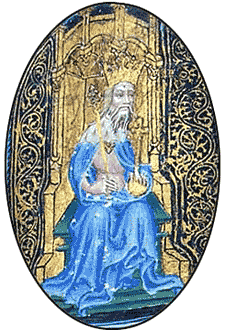

EDWARD III, "of Windsor," King of England, eldest son of Edward II and Isabella of France, was born at
Windsor on the 13th of November 1312. In 1320 he was made Earl of Chester, and in 1325 Duke of Aquitaine, but
he never received the title of Prince of Wales. Immediately after his appointment to Aquitaine, he was sent to France to do homage to his
uncle Charles IV, and remained abroad until he accompanied his mother and Mortimer in their expedition to
England. To raise funds for this he was betrothed to Philippa, daughter of the count of Hainaut.
On the 26th of October 1326, after the fall of Bristol, he was proclaimed warden of the kingdom during his father's absence. On the 13th
of January 1327 parliament recognized him as king, and he was crowned on the 29th of the same month. For the next four years Isabella and
Mortimer governed in his name, though nominally his guardian was Henry, Earl of Lancaster. In the summer
he took part in an abortive campaign against the Scots, and was married to Philippa at York on the 24th of January 1328. On the 15th of
June 1330 his eldest child, Edward, the Black Prince, was born.
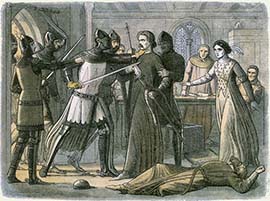 Soon after, Edward made a successful effort to throw off his degrading dependence on his mother and her paramour. In October 1330 he entered
Nottingham Castle by night, through a subterranean passage, and took Mortimer prisoner. On the 29th of November the execution of the favourite
at Tyburn completed the young king's emancipation. Edward discreetly drew a veil over his mother's relations with Mortimer, and treated her
with every respect. There is no truth in the stories that henceforth he kept her in honourable confinement, but her political influence was
at an end.
Soon after, Edward made a successful effort to throw off his degrading dependence on his mother and her paramour. In October 1330 he entered
Nottingham Castle by night, through a subterranean passage, and took Mortimer prisoner. On the 29th of November the execution of the favourite
at Tyburn completed the young king's emancipation. Edward discreetly drew a veil over his mother's relations with Mortimer, and treated her
with every respect. There is no truth in the stories that henceforth he kept her in honourable confinement, but her political influence was
at an end.
Edward III's real reign now begins. Young, ardent and active, he strove with all his might to win back for England something of the position
which it had acquired under Edward I. He bitterly resented the concession of independence to Scotland by the treaty of Northampton of 1328,
and the death of Robert Bruce in 1329 gave him a chance of retrieving his position. The new king of Scots, David, who was his brother-in-law,
was a mere boy, and the Scottish barons, exiled for their support of Robert Bruce, took advantage of the weakness of his rule to invade
Scotland in 1332. At their head was Edward Baliol, whose victory at Dupplin Moor established him for a brief time as king of Scots. After four
months Baliol was driven out by the Scots, whereupon Edward for the first time openly took up his cause. In 1333 the king won in person the
battle of Halidon Hill over the Scots, but his victory did not restore Baliol to power. The Scots despised him as a puppet of the English king,
and after a few years David was finally established in Scotland.
During these years England gradually drifted into hostility with France. The chief cause of this was the impossible situation which resulted
from Edward's position as Duke of Gascony. Contributing causes were Philip's support of the Scots and Edward's alliance with the Flemish cities,
which were then on bad terms with their French overlord, and the revival of Edward's claim, first made in 1328, to the French crown. War broke
out in 1337, and in 1338 Edward visited Coblenz, where he made an alliance with the emperor Louis the Bavarian. In 1339 and 1340 Edward endeavoured
to invade France from the north with the help of his German and Flemish allies, but the only result of his campaigns was to reduce him to bankruptcy.
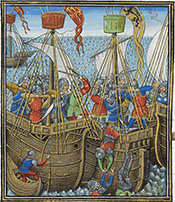 In 1340, however, he took personal part in the great naval battle off Sluys, in which he absolutely destroyed the French navy. In the same year
he assumed the title of King of France. At first he did this to gratify the Flemings, whose scruples in fighting their overlord,
the French king, disappeared when they persuaded themselves that Edward was the rightful king of France. However,
his pretensions to the French crown gradually became more important. The persistence with which he and his successors urged them made stable
peace impossible for more than a century, and this made the struggle famous in history as the Hundred Years' War.
Till the days of George III every English king also called himself king of France.
In 1340, however, he took personal part in the great naval battle off Sluys, in which he absolutely destroyed the French navy. In the same year
he assumed the title of King of France. At first he did this to gratify the Flemings, whose scruples in fighting their overlord,
the French king, disappeared when they persuaded themselves that Edward was the rightful king of France. However,
his pretensions to the French crown gradually became more important. The persistence with which he and his successors urged them made stable
peace impossible for more than a century, and this made the struggle famous in history as the Hundred Years' War.
Till the days of George III every English king also called himself king of France.
Despite his victory at Sluys, Edward was so exhausted by his land campaign that he was forced before the end of 1340 to make a truce and return
to England. He unfairly blamed his chief minister, Archbishop Stratford, for his financial distress, and immediately on his return vindictively
attacked him. Before the truce expired a disputed succession to the duchy of Brittany gave Edward an excuse for renewing hostilities with France.
In 1342 he went to Brittany and fought an indecisive campaign against the French. He was back in England in 1343. In the following years he spent
much time and money in rebuilding Windsor Castle, and instituting the order of the Garter, which he did in order to
fulfil a vow that he had taken to restore the Round Table of Arthur. His finances, therefore, remained embarrassed despite the comparative pause
in the war, although in 1339 he had repudiated his debt to his Italian creditors, a default that brought about widespread misery in Florence.
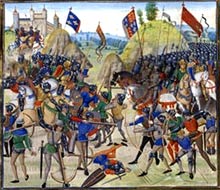 A new phase of
the French war begins when in July 1346 Edward landed in Normandy, accompanied by his eldest son, Edward, Prince of Wales,
a youth of sixteen. In a memorable campaign Edward marched from La Hogue to Caen, and from Caen almost to the gates of Paris. It was a plundering
expedition on a large scale, and like most of Edward's campaigns showed some want of strategic purpose. But Edward's decisive
victory over the French at Crecy, in Ponthieu, on the 26th of August, where he scattered the army with which
Philip VI attempted to stay his retreat from Paris to the northern frontier, signally demonstrated the tactical superiority
of Edward's army over the French. A new phase of
the French war begins when in July 1346 Edward landed in Normandy, accompanied by his eldest son, Edward, Prince of Wales,
a youth of sixteen. In a memorable campaign Edward marched from La Hogue to Caen, and from Caen almost to the gates of Paris. It was a plundering
expedition on a large scale, and like most of Edward's campaigns showed some want of strategic purpose. But Edward's decisive
victory over the French at Crecy, in Ponthieu, on the 26th of August, where he scattered the army with which
Philip VI attempted to stay his retreat from Paris to the northern frontier, signally demonstrated the tactical superiority
of Edward's army over the French.
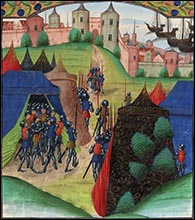 Next year Edward effected the reduction of Calais. This was the most solid and lasting of his conquests, and its
execution compelled him to greater efforts than the Crecy campaign. Other victories in Gascony and Brittany further emphasized his power. In 1346,
David, king of Scots, was also defeated and taken prisoner at Neville's Cross, near Durham. In the midst of his successes, however, want of money
forced Edward to make a new truce in 1347. He was as far from the conquest of France as ever.
Next year Edward effected the reduction of Calais. This was the most solid and lasting of his conquests, and its
execution compelled him to greater efforts than the Crecy campaign. Other victories in Gascony and Brittany further emphasized his power. In 1346,
David, king of Scots, was also defeated and taken prisoner at Neville's Cross, near Durham. In the midst of his successes, however, want of money
forced Edward to make a new truce in 1347. He was as far from the conquest of France as ever.
Edward returned to England in October 1347. He celebrated his triumph by a series of splendid tournaments, and completed his scheme for the establishment
of the order of the Garter. In 1348 he rejected an offer of the imperial throne. In the same year the Black Death first appeared in England, and raged
until 1349. Yet the horrors which it wrought hardly checked the magnificent revels of Edward's court, and neither the plague nor the truce stayed the
course of the French war, though what fighting there was was indecisive and on a small scale. Edward's martial exploits during the next years were those
of a gallant knight rather than those of a responsible general. Conspicuous among them were his famous combat with Eustace de Ribemont, near Calais, in
1349, and the hard-fought naval victory over the Spaniards off Winchelsea, in 1350. Efforts to make peace, initiated by Pope Innocent VI, came to nothing,
though the English commons were now weary of the war. The result of this failure was the renewal of war on a large scale.
In 1355 Edward led an unsuccessful raid out of Calais, and in January and February 1356 harried the Lothians, in the expedition famous as the Burned
Candlemas. His exploits sank into insignificance as compared with those of his son, whose victory at Poitiers, on the 19th of September 1356, resulted
in the captivity of King John, and forced the French to accept a new truce. Edward entertained his royal captive very magnificently, and in 1359
concluded with him the treaty of London, by which John surrendered so much that the French repudiated the treaty.
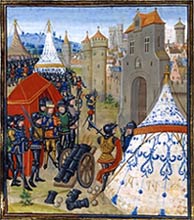 Edward thereupon resolved to invade France afresh and compel its acceptance. On the 28th of October he landed at Calais, and advanced to Reims, where he
hoped to be crowned king of France. The strenuous resistance of the citizens frustrated this scheme, and Edward marched into Burgundy, whence he made his
way back towards Paris. Failing in an attack on the capital, he was glad to conclude, on the 8th of May 1360, preliminaries of peace at Bretigny, near
Chartres. This treaty, less onerous to France than that of London, took its final form in the treaty of Calais, ratified by King John on the 9th of October.
By it Edward renounced his claim to France in return for the whole of Aquitaine.
Edward thereupon resolved to invade France afresh and compel its acceptance. On the 28th of October he landed at Calais, and advanced to Reims, where he
hoped to be crowned king of France. The strenuous resistance of the citizens frustrated this scheme, and Edward marched into Burgundy, whence he made his
way back towards Paris. Failing in an attack on the capital, he was glad to conclude, on the 8th of May 1360, preliminaries of peace at Bretigny, near
Chartres. This treaty, less onerous to France than that of London, took its final form in the treaty of Calais, ratified by King John on the 9th of October.
By it Edward renounced his claim to France in return for the whole of Aquitaine.
The treaty of Calais did not bring rest or prosperity either to England or France. Fresh visitations of the Black Death, in 1362 and 1369, intensified the
social and economic disturbances which had begun with the first outbreak in 1348. Desperate, but not very successful, efforts were made to enforce the
statute of Labourers, of 1351, by which it was sought to maintain prices and wages as they had been before the pestilence. Another feature of these years
was the anti-papal, or rather anti-clerical, legislation embodied in the statutes of Provisors and Praemunire. These measures
were first passed in 1351 and 1353, but often repeated. In 1366 Edward formally repudiated the feudal supremacy over England, still claimed by the papacy
by reason of John's submission. Another feature of the time was the strenuous effort made by Edward to establish his numerous family without too great
expense. In the end the estates of the houses of Lancaster, Kent, Bohun, Burgh and Mortimer swelled the revenues of Edward's children and grandchildren;
in whose favour also the new title of duke was introduced.
In 1369 the French king, Charles V, repudiated the treaty of Calais and renewed the war. Edward's French dominions gladly reverted to their old allegiance,
and Edward showed little of his former vigour in meeting this new trouble. He resumed the title and arms of King of France, but left most of the fighting
and administration of his foreign kingdoms to his sons, Edward and John. While the latter were
struggling with little success against the rising tide of French national feeling, Edward's want of money made him a willing participator in the attack
on the wealth and privileges of the Church. In 1371 a clerical ministry was driven from office, and replaced by laymen, who proved, however, less effective
administrators than their predecessors. Meanwhile Aquitaine was gradually lost; the defeat of Pembroke off La Rochelle deprived England of the command of
the sea, and Sir Owen ap Thomas, a grand-nephew of Llewelyn ab Gruffyd, planned, with French help, an abortive invasion of Wales. In 1371 the
Black Prince came back to England with broken health, and in 1373 John of Lancaster marched to little
purpose through France, from Calais to Bordeaux. In 1372 Edward made his final effort to lead an army, but contrary winds prevented his even landing his
troops in France. In 1375 he was glad to make a truce, which lasted until his death. By it the only important possessions remaining in English hands were
Calais, Bordeaux, Bayonne and Brest.
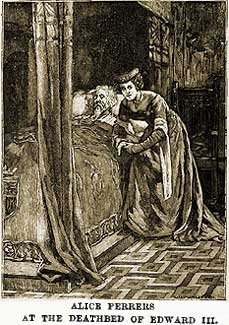 Edward
was now sinking into his dotage. After the death of Queen Philippa he fell entirely under the influence of a greedy mistress named Alice Perrers, while the
Black Prince and John of Gaunt became the leaders of sharply divided parties in the court and council of the king. With the help of Alice Perrers,
John of Gaunt obtained the chief influence with his father, but his administration was neither honourable nor successful. His chief
enemies were the higher ecclesiastics, headed by William of Wykeham, Bishop of Winchester, who had been excluded from power in 1371. John further irritated
the clergy by making an alliance with John Wycliffe. The opposition to John was led by the Black Prince and
Edmund Mortimer, Earl of March, the husband of Edward's grand-daughter, Philippa of Clarence. At last popular indignation
against the courtiers came to a head in the famous Good Parliament of 1376. Alice Perrers was removed from court, and Duke
John's subordinate instruments were impeached. But in the midst of the parliament the death of the Black Prince robbed the commons of their strongest support.
John of Gaunt regained power, and in 1377 a new parliament, carefully packed by the courtiers, reversed the acts of the Good Parliament. Not long after,
Edward III died, on the 21st of June 1377. Edward
was now sinking into his dotage. After the death of Queen Philippa he fell entirely under the influence of a greedy mistress named Alice Perrers, while the
Black Prince and John of Gaunt became the leaders of sharply divided parties in the court and council of the king. With the help of Alice Perrers,
John of Gaunt obtained the chief influence with his father, but his administration was neither honourable nor successful. His chief
enemies were the higher ecclesiastics, headed by William of Wykeham, Bishop of Winchester, who had been excluded from power in 1371. John further irritated
the clergy by making an alliance with John Wycliffe. The opposition to John was led by the Black Prince and
Edmund Mortimer, Earl of March, the husband of Edward's grand-daughter, Philippa of Clarence. At last popular indignation
against the courtiers came to a head in the famous Good Parliament of 1376. Alice Perrers was removed from court, and Duke
John's subordinate instruments were impeached. But in the midst of the parliament the death of the Black Prince robbed the commons of their strongest support.
John of Gaunt regained power, and in 1377 a new parliament, carefully packed by the courtiers, reversed the acts of the Good Parliament. Not long after,
Edward III died, on the 21st of June 1377.
Edward III was not a great man like Edward I. He was, however, an admirable tactician, a consummate knight, and he possessed extraordinary vigour and energy
of temperament. His court, described at length in Froissart's famous chronicle, was the most brilliant in Europe, and he was himself well fitted to be the
head of the magnificent chivalry that obtained fame in the French wars. Though his main ambition was military glory, he was not a bad ruler of England. He
was liberal, kindly, good-tempered and easy of access, and his yielding to his subjects' wishes in order to obtain supplies for carrying on the French war
contributed to the consolidation of the constitution. His weak points were his wanton breaches of good faith, his extravagance, his frivolity and his self-indulgence.
Like that of Edward I his ambition transcended his resources, and before he died even his subjects were aware of his failure.
Edward had twelve children, seven sons and five daughters. Five of his sons played some part in the history of their time, these being
Edward the Black Prince, Lionel of Antwerp, Duke of Clarence,
John of Gaunt, Duke of Lancaster, Edmund of Langley, afterwards Duke of York, and
Thomas of Woodstock, afterwards Duke of Gloucester. John and Edmund are also important as the founders of the rival houses
of Lancaster and York. Each of the last four was named from the place of his birth, and for the same reason the Black
Prince is sometimes called Edward of Woodstock. The king's two other sons both died in infancy. Of his daughters, three died unmarried; the others were
Isabella, who married into the family of Coucy, and Mary, who married into that of Montfort.
Excerpted from:
Encyclopedia Britannica, 11th Ed. Vol VIII.
Cambridge: Cambridge University Press, 1910. 995.
Other Local Resources:
- Edward III and the Black Prince
- Edward III from the tomb in Westminster Abbey
- Tomb of Edward III in Westminster Abbey
- King Edward III and David II of Scotland, 1390
- Edward III in a historiated initial, c1392
- Edward III Pays Homage to Philip VI of France, 1375-80.
- Edward III Pays Homage to Philip VI of France, 1375-80.
- Edward III Pays Homage to Philip VI of France, 1375-1400.
- Edward III Pays Homage to Philip VI of France, early 15th c.
- Edward III Surveys the Dead after Crécy, c1410
- David Bruce Submits to Edward III, c1414
- Edward III Receives the Homage of Scotland, 15th c.
- Edward III with the Arms of France, c1425-50
- Edward III from William Bruges's Garter Book, c1430-40
- Edward III in a historiated initial, c1436
- Edward III in a historiated initial, c1451-1481
- Edward III from Thomas Holme's Book of Arms, c1445-50
- Coronation of Edward III, c1470-5
- The Coronation of Edward III, 15th-c MS
- Coronation of Edward III, late 15th-c.
- Edward III and his Advisors, late 15th-c.
- Edward III in his Camp, late 15th-c.
- Edward III Oil Portait, late 16th-c.
- Edward III Oil Portait, late 16th-c.
- Engraving of Edward III, 1847
- The Great Seal of King Edward III
- Hundred Years' War
- The Battle of Crécy, 1346
- Map of France showing the marches of Edward III
- Wars of the Roses
- House of York
- House of Lancaster
- John of Gaunt, Duke of Lancaster
- Edmund of Langley, Duke of York
Books for further study:
Barber, Richard. Edward III and the Triumph of England.
Penguin Books, 2014.
Bothwell, J. S. Edward III and the English Peerage: Royal Patronage,
Social Mobility and Political Control in Fourteenth-Century England.
Boydell Press, 2004.
Mortimer, Ian. The Perfect King: The Life of Edward III.
Pimlico, 2007.
Ormrod, W. Mark. Edward III.
Yale University Press, 2013.
Rogers, Clifford J. The Wars of Edward III: Sources and Interpretations.
Boydell Press, 2000.
Seward, Desmond. The Hundred Years War: The English in France 1337-1453.
Penguin, 1999.
Sumption, Jonathan. Edward III.
Penguin UK, 2019.
Waugh, Scott L. England in the Reign of Edward III.
Cambridge University Press, 2007.
Edward III on the Web:
 | to Hundred Years' War
|
 | to Luminarium Encyclopedia |
Site ©1996-2023 Anniina Jokinen. All rights reserved.
This page was created on April 23, 2007. Last updated March 25, 2023.
|
Index of Encyclopedia Entries:
Medieval Cosmology
Prices of Items in Medieval England
Edward II
Isabella of France, Queen of England
Piers Gaveston
Thomas of Brotherton, E. of Norfolk
Edmund of Woodstock, E. of Kent
Thomas, Earl of Lancaster
Henry of Lancaster, Earl of Lancaster
Henry of Grosmont, Duke of Lancaster
Roger Mortimer, Earl of March
Hugh le Despenser the Younger
Bartholomew, Lord Burghersh, elder
Hundred Years' War (1337-1453)
Edward III
Philippa of Hainault, Queen of England
Edward, Black Prince of Wales
John of Eltham, Earl of Cornwall
The Battle of Crécy, 1346
The Siege of Calais, 1346-7
The Battle of Poitiers, 1356
Lionel of Antwerp, Duke of Clarence
John of Gaunt, Duke of Lancaster
Edmund of Langley, Duke of York
Thomas of Woodstock, Gloucester
Richard of York, E. of Cambridge
Richard Fitzalan, 3. Earl of Arundel
Roger Mortimer, 2nd Earl of March
The Good Parliament, 1376
Richard II
The Peasants' Revolt, 1381
Lords Appellant, 1388
Richard Fitzalan, 4. Earl of Arundel
Archbishop Thomas Arundel
Thomas de Beauchamp, E. Warwick
Robert de Vere, Earl of Oxford
Ralph Neville, E. of Westmorland
Thomas Mowbray, Duke of Norfolk
Edmund Mortimer, 3. Earl of March
Roger Mortimer, 4. Earl of March
John Holland, Duke of Exeter
Michael de la Pole, E. Suffolk
Hugh de Stafford, 2. E. Stafford
Henry IV
Edward, Duke of York
Edmund Mortimer, 5. Earl of March
Henry Percy, Earl of Northumberland
Sir Henry Percy, "Harry Hotspur"
Thomas Percy, Earl of Worcester
Owen Glendower
The Battle of Shrewsbury, 1403
Archbishop Richard Scrope
Thomas Mowbray, 3. E. Nottingham
John Mowbray, 2. Duke of Norfolk
Thomas Fitzalan, 5. Earl of Arundel
Henry V
Thomas, Duke of Clarence
John, Duke of Bedford
Humphrey, Duke of Gloucester
John Talbot, Earl of Shrewsbury
Richard, Earl of Cambridge
Henry, Baron Scrope of Masham
William de la Pole, Duke of Suffolk
Thomas Montacute, E. Salisbury
Richard Beauchamp, E. of Warwick
Henry Beauchamp, Duke of Warwick
Thomas Beaufort, Duke of Exeter
Cardinal Henry Beaufort
John Beaufort, Earl of Somerset
Sir John Fastolf
John Holland, 2. Duke of Exeter
Archbishop John Stafford
Archbishop John Kemp
Catherine of Valois
Owen Tudor
John Fitzalan, 7. Earl of Arundel
John, Lord Tiptoft
Charles VII, King of France
Joan of Arc
Louis XI, King of France
Charles the Bold, Duke of Burgundy
The Battle of Agincourt, 1415
The Battle of Castillon, 1453
The Wars of the Roses 1455-1485
Causes of the Wars of the Roses
The House of Lancaster
The House of York
The House of Beaufort
The House of Neville
The First Battle of St. Albans, 1455
The Battle of Blore Heath, 1459
The Rout of Ludford, 1459
The Battle of Northampton, 1460
The Battle of Wakefield, 1460
The Battle of Mortimer's Cross, 1461
The 2nd Battle of St. Albans, 1461
The Battle of Towton, 1461
The Battle of Hedgeley Moor, 1464
The Battle of Hexham, 1464
The Battle of Edgecote, 1469
The Battle of Losecoat Field, 1470
The Battle of Barnet, 1471
The Battle of Tewkesbury, 1471
The Treaty of Pecquigny, 1475
The Battle of Bosworth Field, 1485
The Battle of Stoke Field, 1487
Henry VI
Margaret of Anjou
Richard Plantagenet, Duke of York
Edward IV
Elizabeth Woodville
Richard Woodville, 1. Earl Rivers
Anthony Woodville, 2. Earl Rivers
Jane Shore
Edward V
Richard III
George, Duke of Clarence
Ralph Neville, 2. Earl of Westmorland
Richard Neville, Earl of Salisbury
Richard Neville, Earl of Warwick
Edward Neville, Baron Bergavenny
William Neville, Lord Fauconberg
Robert Neville, Bishop of Salisbury
John Neville, Marquis of Montagu
George Neville, Archbishop of York
John Beaufort, 1. Duke Somerset
Edmund Beaufort, 2. Duke Somerset
Henry Beaufort, 3. Duke of Somerset
Edmund Beaufort, 4. Duke Somerset
Margaret Beaufort
Edmund Tudor, Earl of Richmond
Jasper Tudor, Earl of Pembroke
Humphrey Stafford, D. Buckingham
Henry Stafford, Duke of Buckingham
Humphrey Stafford, E. of Devon
Thomas, Lord Stanley, Earl of Derby
Sir William Stanley
Archbishop Thomas Bourchier
Henry Bourchier, Earl of Essex
John Mowbray, 3. Duke of Norfolk
John Mowbray, 4. Duke of Norfolk
John Howard, Duke of Norfolk
Henry Percy, 2. E. Northumberland
Henry Percy, 3. E. Northumberland
Henry Percy, 4. E. Northumberland
William, Lord Hastings
Henry Holland, Duke of Exeter
William Fitzalan, Earl of Arundel
William Herbert, 1. Earl of Pembroke
John de Vere, 12th Earl of Oxford
John de Vere, 13th Earl of Oxford
Thomas de Clifford, 8. Baron Clifford
John de Clifford, 9. Baron Clifford
John Tiptoft, Earl of Worcester
Thomas Grey, 1. Marquis Dorset
Sir Andrew Trollop
Archbishop John Morton
Edward Plantagenet, E. of Warwick
John Talbot, 2. E. Shrewsbury
John Talbot, 3. E. Shrewsbury
John de la Pole, 2. Duke of Suffolk
John de la Pole, E. of Lincoln
Edmund de la Pole, E. of Suffolk
Richard de la Pole
John Sutton, Baron Dudley
James Butler, 5. Earl of Ormonde
Sir James Tyrell
Edmund Grey, first Earl of Kent
George Grey, 2nd Earl of Kent
John, 5th Baron Scrope of Bolton
James Touchet, 7th Baron Audley
Walter Blount, Lord Mountjoy
Robert Hungerford, Lord Moleyns
Thomas, Lord Scales
John, Lord Lovel and Holand
Francis Lovell, Viscount Lovell
Sir Richard Ratcliffe
William Catesby
Ralph, 4th Lord Cromwell
Jack Cade's Rebellion, 1450
Tudor Period
King Henry VII
Queen Elizabeth of York
Arthur, Prince of Wales
Lambert Simnel
Perkin Warbeck
The Battle of Blackheath, 1497
King Ferdinand II of Aragon
Queen Isabella of Castile
Maximilian I, Holy Roman Emperor
King Henry VIII
Queen Catherine of Aragon
Queen Anne Boleyn
Queen Jane Seymour
Queen Anne of Cleves
Queen Catherine Howard
Queen Katherine Parr
King Edward VI
Queen Mary I
Queen Elizabeth I
Henry Fitzroy, Duke of Richmond
Margaret Tudor, Queen of Scotland
James IV, King of Scotland
The Battle of Flodden Field, 1513
James V, King of Scotland
Mary of Guise, Queen of Scotland
Mary Tudor, Queen of France
Louis XII, King of France
Francis I, King of France
The Battle of the Spurs, 1513
Field of the Cloth of Gold, 1520
Charles V, Holy Roman Emperor
Eustace Chapuys, Imperial Ambassador
The Siege of Boulogne, 1544
Cardinal Thomas Wolsey
Archbishop Thomas Cranmer
Thomas Cromwell, Earl of Essex
Thomas, Lord Audley
Thomas Wriothesley, E. Southampton
Sir Richard Rich
Edward Stafford, D. of Buckingham
Thomas Howard, 2nd Duke of Norfolk
Thomas Howard, 3rd Duke of Norfolk
John Dudley, Duke of Northumberland
Charles Brandon, Duke of Suffolk
Thomas Boleyn, Earl of Wiltshire
George Boleyn, Viscount Rochford
John Russell, Earl of Bedford
Thomas Grey, 2. Marquis of Dorset
Henry Grey, D. of Suffolk
Charles Somerset, Earl of Worcester
George Talbot, 4. E. Shrewsbury
Francis Talbot, 5. E. Shrewsbury
Henry Algernon Percy,
5th Earl of Northumberland
Henry Algernon Percy,
6th Earl of Northumberland
Ralph Neville, 4. E. Westmorland
Henry Neville, 5. E. Westmorland
William Paulet, Marquis of Winchester
Sir Francis Bryan
Sir Nicholas Carew
John de Vere, 15th Earl of Oxford
John de Vere, 16th Earl of Oxford
Thomas Seymour, Lord Admiral
Edward Seymour, Protector Somerset
Margaret Pole, Countess of Salisbury
Henry Pole, Lord Montague
Sir Geoffrey Pole
Thomas Manners, Earl of Rutland
Henry Manners, Earl of Rutland
Henry Bourchier, 2. Earl of Essex
Robert Radcliffe, 1. Earl of Sussex
Henry Radcliffe, 2. Earl of Sussex
George Hastings, Earl of Huntingdon
Henry Courtenay, Marquis of Exeter
George Neville, Baron Bergavenny
Sir Edward Neville
William, Lord Paget
William Sandys, Baron Sandys
William Fitzwilliam, E. Southampton
Sir Anthony Browne
Sir Thomas Wriothesley
Sir William Kingston
George Brooke, Lord Cobham
Sir Richard Southwell
Thomas Fiennes, 9th Lord Dacre
Sir Francis Weston
Henry Norris
Lady Jane Grey
Sir Thomas Arundel
Sir Richard Sackville
Sir William Petre
Sir John Cheke
Walter Haddon, L.L.D
Sir Peter Carew
Sir John Mason
Nicholas Wotton
John Taylor
Sir Thomas Wyatt, the Younger
Cardinal Lorenzo Campeggio
Cardinal Reginald Pole
Stephen Gardiner, Bishop of Winchester
Edmund Bonner, Bishop of London
Nicholas Ridley, Bishop of London
John Hooper, Bishop of Gloucester
John Aylmer, Bishop of London
Thomas Linacre
William Grocyn
Archbishop William Warham
Cuthbert Tunstall, Bishop of Durham
Richard Fox, Bishop of Winchester
Edward Fox, Bishop of Hereford
Pope Julius II
Pope Leo X
Pope Clement VII
Pope Paul III
Pope Pius V
Pico della Mirandola
Desiderius Erasmus
Martin Bucer
Richard Pace
Christopher Saint-German
Thomas Tallis
Elizabeth Barton, the Nun of Kent
Hans Holbein, the Younger
The Sweating Sickness
Dissolution of the Monasteries
Pilgrimage of Grace, 1536
Robert Aske
Anne Askew
Lord Thomas Darcy
Sir Robert Constable
Oath of Supremacy
The Act of Supremacy, 1534
The First Act of Succession, 1534
The Third Act of Succession, 1544
The Ten Articles, 1536
The Six Articles, 1539
The Second Statute of Repeal, 1555
The Act of Supremacy, 1559
Articles Touching Preachers, 1583
Queen Elizabeth I
William Cecil, Lord Burghley
Robert Cecil, 1st Earl of Salisbury
Sir Francis Walsingham
Sir Nicholas Bacon
Sir Thomas Bromley
Robert Dudley, Earl of Leicester
Ambrose Dudley, Earl of Warwick
Henry Carey, Lord Hunsdon
Sir Thomas Egerton, Viscount Brackley
Sir Francis Knollys
Katherine "Kat" Ashley
Lettice Knollys, Countess of Leicester
George Talbot, 6. E. of Shrewsbury
Elizabeth, Countess of Shrewsbury
Gilbert Talbot, 7. E. of Shrewsbury
Sir Henry Sidney
Sir Robert Sidney
Archbishop Matthew Parker
Walter Devereux, 1st Earl of Essex
Robert Devereux, 2nd Earl of Essex
Penelope Devereux, Lady Rich
Sir Christopher Hatton
Edward Courtenay, E. Devonshire
Edward Manners, 3rd Earl of Rutland
Thomas Radcliffe, 3. Earl of Sussex
Henry Radcliffe, 4. Earl of Sussex
Robert Radcliffe, 5. Earl of Sussex
William Parr, Marquis of Northampton
Henry Wriothesley, 2. Southampton
Henry Wriothesley, 3. Southampton
Charles Neville, 6. E. Westmorland
Thomas Percy, 7. E. Northumberland
Henry Percy, 8. E. Northumberland
Henry Percy, 9. E. Nothumberland
William Herbert, 1. Earl of Pembroke
Charles, Lord Howard of Effingham
Thomas Howard, 4th Duke of Norfolk
Henry Howard, 1. Earl of Northampton
Thomas Howard, 1. Earl of Suffolk
Henry Hastings, 3. E. of Huntingdon
Edward Manners, 3rd Earl of Rutland
Roger Manners, 5th Earl of Rutland
Francis Manners, 6th Earl of Rutland
Henry FitzAlan, 12. Earl of Arundel
Thomas, Earl Arundell of Wardour
Edward Somerset, E. of Worcester
William Davison
Sir Walter Mildmay
Sir Ralph Sadler
Sir Amyas Paulet
Gilbert Gifford
Anthony Browne, Viscount Montague
François, Duke of Alençon & Anjou
Mary, Queen of Scots
Henry Stuart, Lord Darnley
James Hepburn, Earl of Bothwell
Anthony Babington and the Babington Plot
John Knox
Philip II of Spain
The Spanish Armada, 1588
Sir Francis Drake
Sir John Hawkins
William Camden
Archbishop Whitgift
Martin Marprelate Controversy
John Penry (Martin Marprelate)
Richard Bancroft, Archbishop of Canterbury
John Dee, Alchemist
Philip Henslowe
Edward Alleyn
The Blackfriars Theatre
The Fortune Theatre
The Rose Theatre
The Swan Theatre
Children's Companies
The Admiral's Men
The Lord Chamberlain's Men
Citizen Comedy
The Isle of Dogs, 1597
Common Law
Court of Common Pleas
Court of King's Bench
Court of Star Chamber
Council of the North
Fleet Prison
Assize
Attainder
First Fruits & Tenths
Livery and Maintenance
Oyer and terminer
Praemunire
The Stuarts
King James I of England
Anne of Denmark
Henry, Prince of Wales
The Gunpowder Plot, 1605
George Villiers, 1st Duke of Buckingham
Robert Carr, Earl of Somerset
Arabella Stuart, Lady Lennox
William Alabaster
Bishop Hall
Bishop Thomas Morton
Archbishop William Laud
John Selden
Lucy Harington, Countess of Bedford
Henry Lawes
King Charles I
Queen Henrietta Maria
Long Parliament
Rump Parliament
Kentish Petition, 1642
Thomas Wentworth, Earl of Strafford
John Digby, Earl of Bristol
George Digby, 2nd Earl of Bristol
Thomas Fairfax, 3rd Lord Fairfax
Robert Devereux, 3rd E. of Essex
Robert Sidney, 2. E. of Leicester
Algernon Percy, E. of Northumberland
Henry Montagu, Earl of Manchester
Edward Montagu, 2. Earl of Manchester
The Restoration
King Charles II
King James II
Test Acts
Greenwich Palace
Hatfield House
Richmond Palace
Windsor Palace
Woodstock Manor
The Cinque Ports
Mermaid Tavern
Malmsey Wine
Great Fire of London, 1666
Merchant Taylors' School
Westminster School
The Sanctuary at Westminster
"Sanctuary"
Images:
Chart of the English Succession from William I through Henry VII
Medieval English Drama
London c1480, MS Royal 16
London, 1510, the earliest view in print
Map of England from Saxton's Descriptio Angliae, 1579
London in late 16th century
Location Map of Elizabethan London
Plan of the Bankside, Southwark, in Shakespeare's time
Detail of Norden's Map of the Bankside, 1593
Bull and Bear Baiting Rings from the Agas Map (1569-1590, pub. 1631)
Sketch of the Swan Theatre, c. 1596
Westminster in the Seventeenth Century, by Hollar
Visscher's View of London, 1616
Larger Visscher's View in Sections
c. 1690. View of London Churches, after the Great Fire
The Yard of the Tabard Inn from Thornbury, Old and New London
|
|